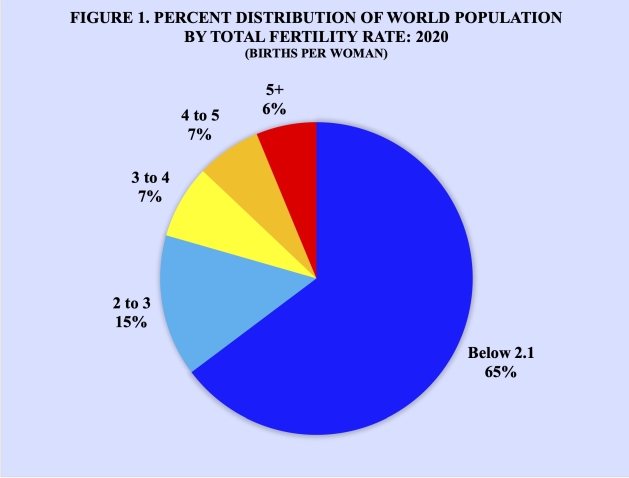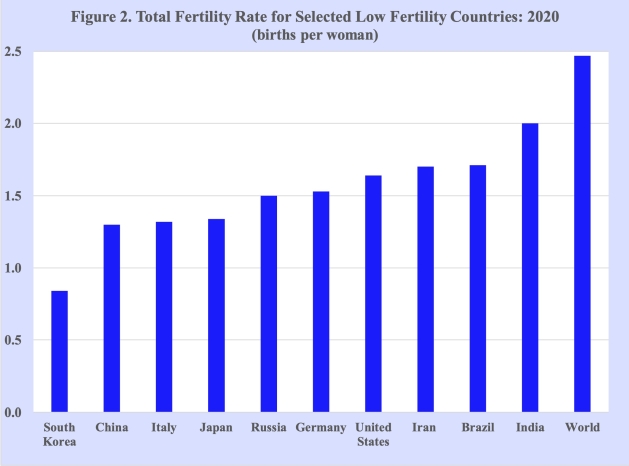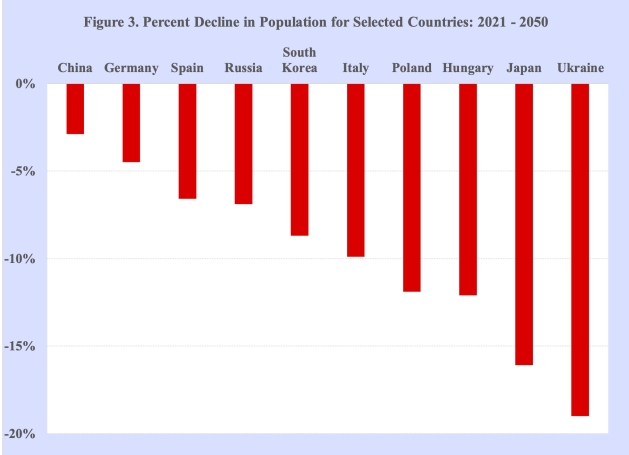Future Fertility Fantasies

PORTLAND, USA, Dec 08 (IPS) - Many low fertility countries are having future fertility fantasies. It’s time for them to end those fantasies and prepare for a future of below replacement fertility with demographic ageing and without immigration declining populations.
Over the past 50 years the general fertility pattern has been unmistakable: once a nation’s fertility rate falls below the replacement level, it tends to stay there. Despite this demographic pattern, the governments of many countries with below replacement fertility believe that they can persuade couples to have additional children.
Today the fertility rates of approximately 80 countries and territories are below the replacement level, i.e., less than 2.1 children per woman. Together those countries represent nearly two-thirds of the world’s population of nearly 8 billion people (Figure 1).
 Source: United Nations Population Division.
Source: United Nations Population Division.
Countries with below replacement fertility are all the developed countries as well many developing countries, including Brazil, Chile, China, Columbia, Cuba, Iran, Malaysia, Maldives, Nepal, South Korea, Thailand and Turkey. The latest addition to this group is India, which recently announced that its fertility rate had fallen just below the replacement level at 2.0 births per woman.
Many of those countries have fertility rates that are more than a half child below the replacement level. For example, the total fertility rates for China, Italy and Japan are 1.3 births per woman. An even lower fertility rate is that of South Korea, which at 0.8 births per woman is the world’s lowest (Figure 2).
 Source: National surveys and United Nations Population Division.
Source: National surveys and United Nations Population Division.
Largely the result of sustained below replacement fertility levels, many countries are experiencing or facing population decline. By midcentury, for example, the populations of nearly 40 countries are expected to be smaller than they are today, including China, Germany, Hungary, Italy, Japan, Poland, Russia, South Korea, Spain and Ukraine (Figure 3).
 Source: United Nations Population Division.
Source: United Nations Population Division.
In addition to population decline, the age structures of those countries will undergo rapid demographic ageing. Over the coming decades the proportion aged 65 years and older in countries with below replacement fertility will increase substantially.
By 2050, for example, many nations, including Belarus, Brazil, Canada, Chile, China, Costa Rica, Cuba, France, Germany, Hungary, New Zealand, Sweden, Thailand, the United Kingdom and Ukraine, are expected to have approximately one-fourth of their populations aged 65 years and older. Also in some countries, such as Greece, Italy, Japan, Poland, Singapore and South Korea, the proportion elderly will be no less than one-third of their populations.
Rather than turning to international migration to increase or stabilize the size of their populations and labor forces, as some countries such as Australia, Canada and the United States are doing, many countries want to raise their low fertility levels. Those governments maintain that the only truly sustainable solution to population decline and demographic ageing is to raise the fertility rates of their own indigenous populations to at least the replacement level.
While immigration may increase the size of the population and labor force as is occurring in some countries, it will not reverse population ageing, which is the result of low fertility levels and increased longevity. In addition, the numbers of immigrants needed to offset population aging in most cases would not only be unacceptably large, but also over the longer term the immigrants themselves would age and eventually join the elderly population.
Of course, fertility rebounds in the near future are certainly possible and cannot be ruled out. However, population projections for countries over the 21st century generally expect that once fertility rates fall below the replacement level, they will remain there.
Virtually every country’s fertility rate is expected to remain below the replacement level once its fertility rate has fallen below 2.1 births per woman. In addition, by the close of the century only about 20 countries, virtually all in Africa, are projected to have fertility rates slightly about the replacement level, or about 2.2 births per woman.
Some countries believe that the demographic consequences of below replacement fertility constitute threats to their economy, society and culture. Those countries have attempted to return to at least replacement level fertility through pro-natalist policies, programs and various incentives, including reduced taxes, subsidized care for children, parental leave and financial bonuses, as well as limiting access to contraceptives and abortion. However, governmental pro-natalist attempts have by and large failed to raise fertility back to the replacement level.
Powerful forces are responsible for bringing about and maintaining fertility rates below replacement levels. In addition to urbanization, education, employment and modern contraceptives, other important forces influencing the fertility decisions of women and men include the costs of living, pressures and demands of childrearing, improved status of women, decline of marriage, increased divorce and separation, career aspirations, childlessness and independent lifestyles.
Given the likely trends in fertility rates, many countries should anticipate and prepare for a demographic future of smaller and older populations. Official retirement ages, for example, will need to be raised, perhaps to 70 years, which will not only increase the size of the labor force, but also reduce the numbers of retired persons.
In addition, countries will need to turn to and invest in advanced robotics, androids and artificial intelligence. Not only will existing and emerging technologies help to address the shrinking labor forces, but they will also contribute to meeting the needs of elderly persons.
Besides programs promoting healthy ageing, preparing people for old age and making services and assistance readily available will be required for the growing numbers and proportions of elderly persons. To meet the increasing demands, governments will need to seriously reconsider their budgets, taxes and priorities, particularly expenditures on healthcare and defense.
The era of relatively high fertility, which was most recently experienced during the mid-20th century, is largely over. It is increasingly being replaced by low fertility rates, typically below replacement levels.
In all likelihood, world population is projected to add billions more in the coming decades, likely reaching 10 billion around mid-century. At the same time, countries need to acknowledge the realities of today’s fertility levels and their likely trends and major consequences in the coming decades.
In sum, many governments of low fertility countries need to dismiss their fantasies about returning to the comparatively high fertility levels of the past. They need to prepare their countries for a future of sustained below replacement fertility with demographic ageing and without immigration declining populations.
Joseph Chamie is an international consulting demographer, a former director of the United Nations Population Division and author of numerous publications on population issues, including his recent book, "Births, Deaths, Migrations and Other Important Population Matters."
© Inter Press Service (2021) — All Rights Reserved. Original source: Inter Press Service
 Global Issues
Global Issues